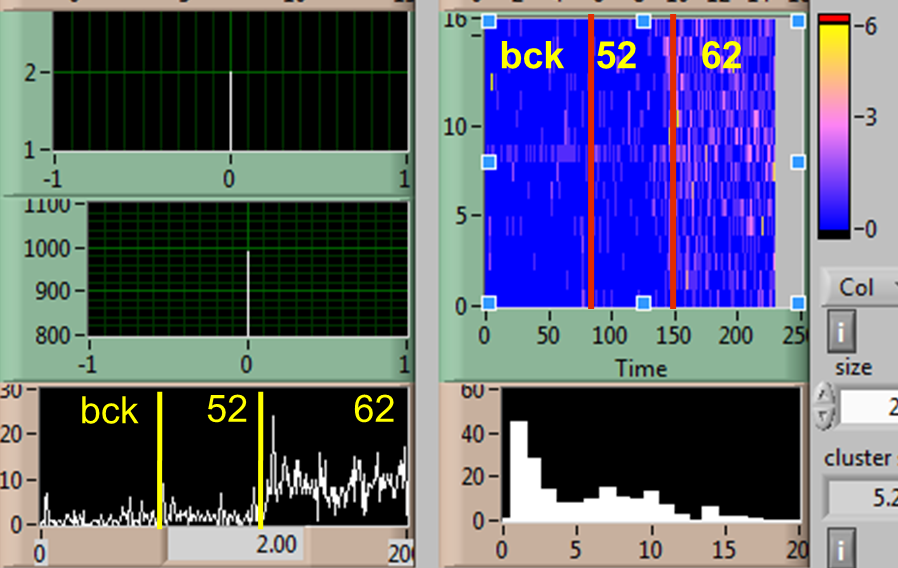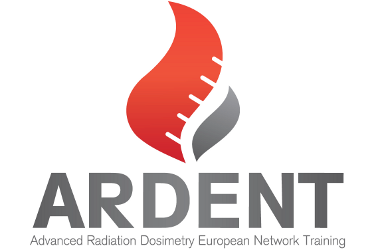Silvia Puddu esr03 - Log Records of my activities throughout the ARDENT training
Experiments
January 2013
Radioactive Waste Characterization
Storage zones for radioactive waste at CERN are near to saturation. With Long Shut down 1 (LS1) situation is going to get worse because of the upgrade of devices. It is necessary a fast way to classify the waste in order to treat it.
Gamma emitters can be easily measured thanks to gamma spectrometry and scintillators. One of major task is the measurements of 55Fe while the background is rapresentes by gamma emitters and above all by 60Co.
For these reasons a detector with high efficiency to ~6 keV of 55Fe and high gamma rejection is needed. The proposal is to build a system based on Gas Electron Multiplier (GEM) detector.
In January I started this activity characterising with sources a detector with these features:
- Drift gap: 3 mm
- Sensitive area: 25 cm2
- Gas mixture: Ar/CO2 70%/30%
In figure below the characterization of the detector is shown.

Efficiency of 3mm camera to 55Fe emission is ~10% (theoretically calculated) while efficiency to 60Co emission is 0.3%
Experiments
February 2013
Radioactive Waste Characterization
In order to increase the sensitivuty to X ray an other detector has been built and characterised in February:
- Drift gap: 40 mm
- Sensitive area: 100 cm2
- Gas mixture: Ar/CO2 70%/30%
In figure below, the characterization with sources of 40 mm drift detector

Experiments
March 2013
Radioactive Waste Characterization
Thanks to the characterization the working points have been chosen for the two detectors.
Several samples with known activities have been measured.
In Figures below, the screeshots taken with the exposition of the 3 mm detector (left) and the 40 mm detector (right) with radioactive samples


In the table below the characteristic of the measured samples
| Sample Name | Fe-55 in Bq/gr | Co-60 in Bq/gr |
|---|---|---|
| 52 | 7.1 | 7.8 |
| 62 | 24.0 | 66.0 |
Training
22-26 April 2013
Ntuple generation with FLUKA
I have spent a week in Dresden at HZDR with Dr. A. Ferrari to learn how to generate an ntuple with FLUKA code
Experiments
April 2013
Ntuple generation with FLUKA code
In order to optimize performances of GEM detectors, it is useful to simulate the phenomena involved during the detection. For this task a tool based on FLUKA code has been built to obtain the ntuple. With ntuple we are going to be able to study event by event the processes inside the detector and to optimize the choice of materials and their thickness.
Outreach
May 2013
I have always been interest for the outreach activity because I think that is fundamental to show to the people how science can influence everyday life. Since it is strongly recommended to promote the ARDENT project, I have thought about that as an occasion and I have organised some seminar in the high school of my native, lovely city: Cagliari. Seminars have been in the two branch of the School "Istituto Tecnico e Liceo Scientifico delle Scienze Applicate M. Giua" and at the "Liceo Scientifico L. B. Alberti" (my old high school).
The seminars have been prepared for students of the last years (4th and 5th) of the scientific high schools, which have to choose the university. The title is "ARDENT for Dummies" that recall the famous series of manuals for beginner, which are about several topics.
Why the students? In my experience I have seen that Physics is felt as detached and difficult and professional correlated activities are not clear. This feeling usually is uncorrelated with the teacher's ability. Since the ARDENT project has a very strong, applicative feature, it is a good topic to revive the interest for the subject.
Each seminar has been about 1:30 h for more or less 70 students. The subject were:
- Video about CERN
- Why doing research?
- Radioactivity
- Interaction between radiation and materials
- ARDENT
- Dosimetry
- Detectors for neutron dosimetry
- Hadrontherapy
- Beam monitoring
Experiments
January 2013
Radioactive Waste Characterization
Storage zones for radioactive waste at CERN are near to saturation. With Long Shut down 1 (LS1) situation is going to get worse because of the upgrade of devices. It is necessary a fast way to classify the waste in order to treat it.
Gamma emitters can be easily measured thanks to gamma spectrometry and scintillators. One of major task is the measurements of 55Fe while the background is rapresentes by gamma emitters and above all by 60Co.
For these reasons a detector with high efficiency to ~6 keV of 55Fe and high gamma rejection is needed. The proposal is to build a system based on Gas Electron Multiplier (GEM) detector.
In January I started this activity characterising with sources a detector with these features:
- Drift gap: 3 mm
- Sensitive area: 25 cm2
- Gas mixture: Ar/CO2 70%/30%
In figure below the characterization of the detector is shown.

Efficiency of 3mm camera to 55Fe emission is ~10% (theoretically calculated) while efficiency to 60Co emission is 0.3%
Experiments
February 2013
Radioactive Waste Characterization
In order to increase the sensitivuty to X ray an other detector has been built and characterised in February:
- Drift gap: 40 mm
- Sensitive area: 100 cm2
- Gas mixture: Ar/CO2 70%/30%
In figure below, the characterization with sources of 40 mm drift detector

Experiments
March 2013
Radioactive Waste Characterization
Thanks to the characterization the working points have been chosen for the two detectors.
Several samples with known activities have been measured.
In Figures below, the screeshots taken with the exposition of the 3 mm detector (left) and the 40 mm detector (right) with radioactive samples


In the table below the characteristic of the measured samples
| Sample Name | Fe-55 in Bq/gr | Co-60 in Bq/gr |
|---|---|---|
| 52 | 7.1 | 7.8 |
| 62 | 24.0 | 66.0 |
Training
22-26 April 2013
Ntuple generation with FLUKA
I have spent a week in Dresden at HZDR with Dr. A. Ferrari to learn how to generate an ntuple with FLUKA code
Experiments
April 2013
Ntuple generation with FLUKA code
In order to optimize performances of GEM detectors, it is useful to simulate the phenomena involved during the detection. For this task a tool based on FLUKA code has been built to obtain the ntuple. With ntuple we are going to be able to study event by event the processes inside the detector and to optimize the choice of materials and their thickness.
Outreach
May 2013
I have always been interest for the outreach activity because I think that is fundamental to show to the people how science can influence everyday life. Since it is strongly recommended to promote the ARDENT project, I have thought about that as an occasion and I have organised some seminar in the high school of my native, lovely city: Cagliari. Seminars have been in the two branch of the School "Istituto Tecnico e Liceo Scientifico delle Scienze Applicate M. Giua" and at the "Liceo Scientifico L. B. Alberti" (my old high school).
The seminars have been prepared for students of the last years (4th and 5th) of the scientific high schools, which have to choose the university. The title is "ARDENT for Dummies" that recall the famous series of manuals for beginner, which are about several topics.
Why the students? In my experience I have seen that Physics is felt as detached and difficult and professional correlated activities are not clear. This feeling usually is uncorrelated with the teacher's ability. Since the ARDENT project has a very strong, applicative feature, it is a good topic to revive the interest for the subject.
Each seminar has been about 1:30 h for more or less 70 students. The subject were:
- Video about CERN
- Why doing research?
- Radioactivity
- Interaction between radiation and materials
- ARDENT
- Dosimetry
- Detectors for neutron dosimetry
- Hadrontherapy
- Beam monitoring
















